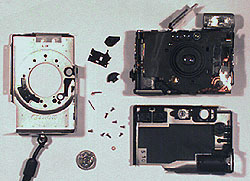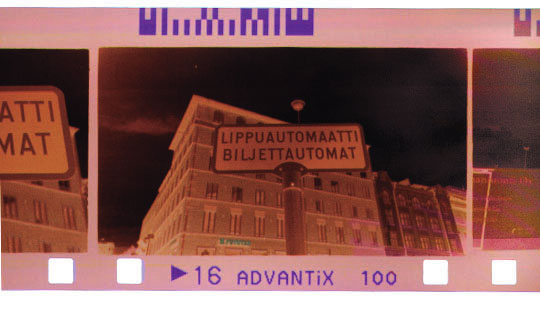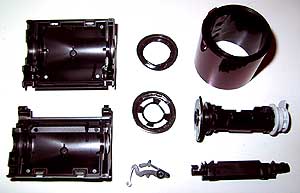"Exploded" ELPH/IXUS camera
After 2 1/2 years in my hip pocket every day, my trusty Canon Elph (IXUS here in Europe) had accumulated quite a lot of dust and dirt in the viewfinder. So, after purchasing a new Elph Jr. (Ixus L-1), I took the courage to open up the old camera for a thorough New Year's cleaning...
Here's what I found - I shot an "exploded" view of the camera (with a Color QuickCam):

In order to open the camera, I had to loosen quite a few screws, remove the film chamber lock, and to get to the finder I also had to remove some miscellaneous small covers inside the camera... This is NOT something I recommend you to do yourself (unless you want to take the risk of destroying your camera). I have the special tools needed for camera service work - and a steady hand. Still, I managed to destroy the threads of one hole in the camera body (the screws are self-tapping, going into soft plastic!), and had to machine a replacemet screw and recessed nut on my lathe, in order to repair the damage...

Here you see the front of the camera innards. The electronics are on a flexible circuit board that encircles almost the whole camera body. The motor that focuses the lens is very tiny (20mm x 12mm - 3/4 x 1/2 inch), below the lens. I did not disassemble the camera any further than I had in order to get to clean the dust out of the finder...

Here's the back of the camera. I had to de-solder the LCD display to get below it, to open the finder optics where the dust had collected - all the finder lenses are plastic, and they seem to attract dust by static electricity. The electronic flash's capacitor is on the lower back side of the camera, just following the battery compartment. (Warning - a flash capacitor charges to several hundred volts, which can be lethal!)
So, now you know how an Elph/IXUS looks inside. I'm surprised at the amount of VERY diminutive mechanics, plastics mostly, and I'm surprised that the camera has survived 2 1/2 years in my pocket, every day... (I lost two Minox 35's due to dust in the shutter mechanism, some years ago!)
APS negative
For those of you who are curious about what an APS negative looks like, and do not wish to open up a cassette (not recommended, anyway), here's a scan of one:
The film is 24 mm wide (just a little under one inch) and the frame is 16.7 x 30.2 mm (approx. 5/8 x 1 1/4 inch). Note the two perforations per frame (35 mm has 8), and the barcode which tells the printing machine the frame number (such codes are used on 35mm as well). The APS-specific transparent magnetic coating that carries the PQI information can't be seen, naturally. Many cameras sense the position of the film optically, using infrared LEDs to "see" the perforations. If you put a developed film (which is tranparent, as opposed to an undeveloped one) into such a camera, it will generate an error message - the Elph/Ixus displays an "H", and has to be reset by removing and replacing the battery. NEVER open an APS film cassette! It has single-use fasteners that will be destroyed if the cassette is opened. Since you're curious anyway, I destroyed one to show you the parts it's made of: You can see the two halves of the outer casing, two round flanges, the spring for keeping the spool in the correct position (the icons showing un-/half-/exposed/printed are on the revolving spool, so don't turn it to another setting inadvertently!), the light trap door, the spool (made of two parts, click-fitted together), and the film itself. Putting this back together again is impossible, since two tabs had to be broken when the cassette was opened.
KODAK has a very good page about the APS system, click HERE!











